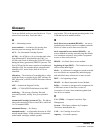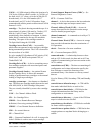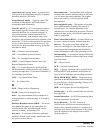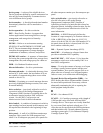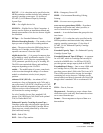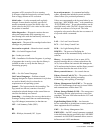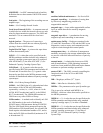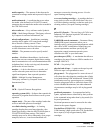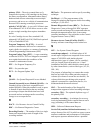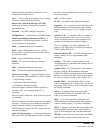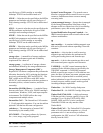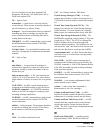
Glossary 661
1st ed., 6/30/04 - 312579601
programs at IPL execution. Devices running
µ-software reload the functional µ-software usually
from a floppy diskette at IPL execution.
initial value— A value assumed until explicitly
changed. It must then be explicitly specified in
another command to restore the initial value. An
initial value for the HSC is the value in effect when
the product is installed.
inline diagnostics— Diagnostic routines that test
subsystem components while operating on a
time-sharing basis with the functional µ-software in
the subsystem component.
input stack— The part of the cartridge loader where
cartridges are premounted.
intervention required— Manual action is needed.
IPL— See Initial Program Load.
ips— Inches per second.
IVP— Installation Verification Programs. A package
of programs that is run by a user after the library is
installed in order to verify that the library is
functioning properly.
J
JCL— See Job Control Language.
Job Control Language— Problem-oriented
language designed to express statements in a job that
are used to identify the job or describe its
requirements to an operating system.
journal— The log associated with journaling. The
log (stored in a data set) contains a record of
completed work and changes to the control data set
since the last backup was created.
journaling— A technique for recovery that involves
creating a backup control data set and maintaining a
log of all changes (transactions) to that data set.
JST— Job Summary Table (JES3).
K
KB— Kilobyte, thousand (10 3 ) bytes.
keyword parameter— In command and utility
syntax, operands that include keywords and their
related values (See positional parameter).
Values are concatenated to the keyword either by an
equal sign, ‘‘KEYWORD=value,’’ or by parentheses,
‘‘KEYWORD(value).’’ Keyword parameters can be
specified in any order. The HSC accepts (tolerates)
multiple occurrences of a keyword. The value
assigned to a keyword reflects the last occurrence of
a keyword within a command.
L
LAN— See Local Area Network.
LCU— See Library Control Unit.
LED— See Light Emitting Diode.
LIBGEN— The process of defining the
configuration of the automated library to the host
software.
library— An installation of one or more ACSs,
attached cartridge drives, volumes placed into the
ACSs, host software that controls and manages the
ACSs and associated volumes, and the library control
data set that describes the state of the ACSs.
library control data set— See control data set.
Library Control Unit (LCU)— The portion of the
LSM that controls the picking, mounting,
dismounting, and replacing of cartridges.
Library Management Unit (LMU)— The portion
of the ACS that manages from one to sixteen LSMs
and communicates with the host CPU.
Library Storage Module (LSM)— The storage area
for cartridges plus the robot necessary to move the
cartridges. The term LSM often means the LCU and
LSM combined.
Light Emitting Diode (LED)— An electronic
device used mainly as an indicator on status panels to
show equipment on/off conditions.
LMU— See Library Management Unit.
LMUPATH— An HSC control statement contained
in the definition data set specified by the LMUPDEF
command. An LMUPATH statement allows users to
define network LMU attachments.





